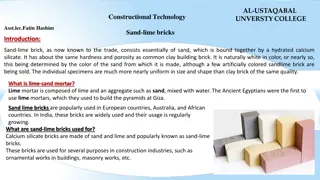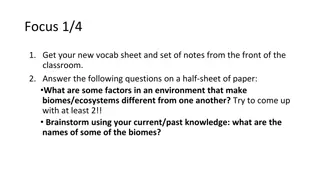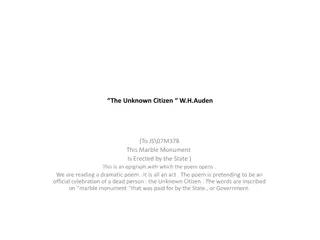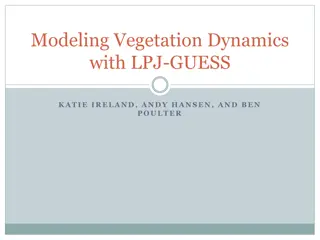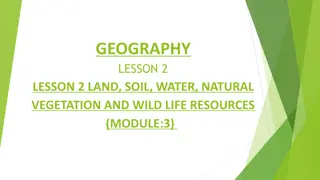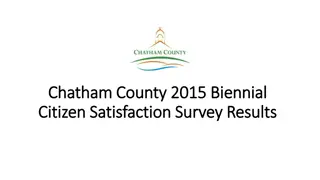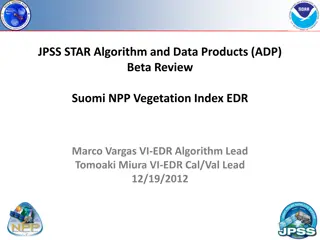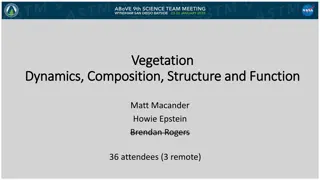Understanding Sand Dune Vegetation: Citizen Science Survey
Conduct a vegetation survey to track changes in sand dune ecosystems over time. Monitor bare sand cover, vegetation types, plant species health indicators, and nutrient levels. Learn how to conduct the survey to help inform management decisions and preserve dune environments effectively.
Download Presentation

Please find below an Image/Link to download the presentation.
The content on the website is provided AS IS for your information and personal use only. It may not be sold, licensed, or shared on other websites without obtaining consent from the author. Download presentation by click this link. If you encounter any issues during the download, it is possible that the publisher has removed the file from their server.
E N D
Presentation Transcript
Dynamic Dunescapes Citizen Science: Vegetation Survey v
Vegetation survey Vegetation surveys can help deepen our understanding of sand dunes by addressing a variety of questions to help inform management decisions. This survey is designed to: Record the percentage cover of bare sand and the cover and height of broad vegetation types. This will allow us to examine whether the composition and structure of the vegetation at the site is changing over time. Record the percentage cover of plant species that are positive and negative indicators of dune health (including rare species and invasive species) so we can track how the health of the sand dune system is changing over time. Record the percentage cover of species which indicate higher nutrient levels.
Why? What is the percentage cover of bare sand and broad vegetation types in different zones of the sand dune system? How is this changing over time and is it different in managed and unmanaged areas? A loss of bare sand in mobile dune areas, for example, could be indicative of the system becoming increasingly vegetated and so less dynamic. What is the percentage cover of short vegetation in fixed dune grassland zones? A loss of short vegetation in these areas could suggest a loss of dynamism, an increase in nutrient enrichment or a change in grazing regime.
Why? What is the distribution and percentage cover of plant species that are positive and negative indicators of dune health? How is this changing over time and is it different in managed and unmanaged areas? An increase in negative indicators could be a sign of a decline in the health of the sand dune system. What is the distribution and percentage cover of plant species that are indicators of nutrient enrichment? How is this changing over time and is it different in managed and unmanaged areas? This will give an indication of how the site is being affected by nutrient enrichment.
Conducting the survey Vegetation surveys should be completed annually in June to August at permanently marked quadrat locations across a range of habitats (quadrats in mobile dune areas may not be permanently marked). This video explains how you to survey vegetation using a quadrat on sand dunes. Watch this video on YouTube: https://youtu.be/IO4uqPGQPnU
Conducting the survey This video explains how you survey indicator species on sand dunes. Watch this video on YouTube: https://youtu.be/jL1gwP_z1Zk
Recording your survey data Your survey results can be recorded on the Dynamic Dunescapes app. This video will show you how to do this. The Dynamic Dunescapes app is available to download for free here: https://dynamicdunescapes.co.uk/dunescapes-citizen-science-app/ If you are using paper recording forms, please return them to your Site Manager. Watch this video on YouTube: https://youtu.be/HZUvVzDCH2E
Suggested equipment Handheld GPS unit Mobile phone app quadrat locations downloaded beforehand Compass Long tape measure (> 10 metre) Ruler (1 metre, or short tape measure) 4 marking canes Grid references for the quadrats you intend to survey Quadrat recording form Plant indicator species list and identification guide
Supporting Documents There are several additional documents available at www.dynamicdunescapes.co.uk/citizenscience to help you complete this citizen science task: Survey method Vegetation survey recording form Health and Safety Guidance
Dynamic Dunescapes www.dynamicdunescapes.co.uk @dynamicdunes v


